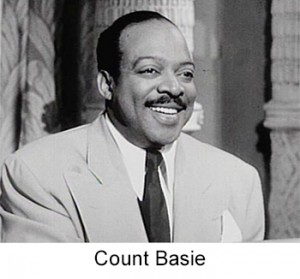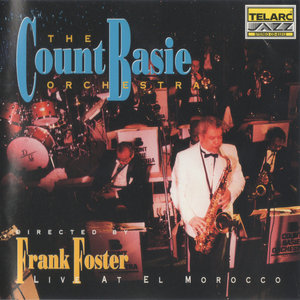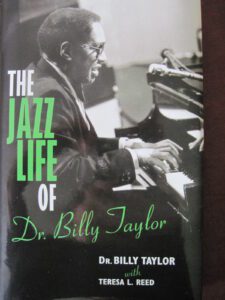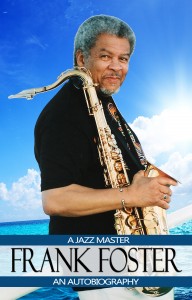Google the name of famed saxophonist Frank Foster (who died of kidney failure in 2011) and you’ll discover a long list of accomplishments. Here’s a snippet from his July 26, 2011 New York Times obit by Nate Chinen:
Frank Foster, a saxophonist, composer and arranger who helped shape the sound of the Count Basie Orchestra during its popular heyday in the 1950s and ’60s and later led expressive large and small groups of his own, died on Tuesday at his home in Chesapeake, Va. He was 82.
. . . Mr. Foster had a varied and highly regarded career as a bandleader, notably with his Loud Minority Big Band, and he was sought after as an arranger for large ensembles. But it was the strength of his contribution to the so-called New Testament edition of the Basie band, from 1953 to 1964, that anchors his place in jazz history.
Mr. Foster wrote and arranged a number of songs for the band, none more celebrated than “Shiny Stockings,” a puckishly genteel theme set at a cruising medium tempo with a slow but powerful crescendo. Recorded by Basie on his classic 1955 album “April in Paris,” it subsequently became both a band signature and a jazz standard, often performed with lyrics (there were two sets, one by Ella Fitzgerald and one by Jon Hendricks).
He was one of two musicians named Frank in the band’s saxophone section, the other being the tenor saxophonist and flutist Frank Wess. Their contrasting styles as soloists — Mr. Foster was the more robust, with a harder husk to his tone — became the basis of a popular set piece called  “Two Franks,” written for the band by Neal Hefti.
“Two Franks,” written for the band by Neal Hefti.
After leaving Basie, Mr. Foster worked for a while as a freelance arranger, supporting the likes of Frank Sinatra and Sarah Vaughan.
He returned to the Basie band in the mid-1980s, this time as its leader. (Count Basie died in 1984.) He held the post for nearly a decade and earned something like emeritus status: when the Count Basie Orchestra was enlisted for Tony Bennett’s 2008 album “A Swingin’ Christmas,” Mr. Foster was the arranger.
Even as he spent a good portion of the late 1960s and ’70s exploring harmonic and rhythmic abstraction, Mr. Foster never quite surrendered to it. And he was no purist about jazz-funk — “Manhattan Fever,” one of his best albums, released in 1968 on Blue Note, has several effervescent backbeat-driven tunes.
In 2001 Mr. Foster had a stroke that hindered his ability to play the saxophone. He was named a National Endowment for the Arts Jazz Master the following year, and continued to write and arrange music, often as a commission for organizations like the Jazz at Lincoln Center Orchestra. He also became active in the Jazz Foundation of America, a nonprofit organization that delivers aid to musicians in need.
Quite a resume: a long-standing tenure with the Basie Band as a player/arranger and then as  leader, composer of numerous jazz standards, and NEA Jazz Master, among other accomplishments. These are highly admirable musical credentials not easily come by.
leader, composer of numerous jazz standards, and NEA Jazz Master, among other accomplishments. These are highly admirable musical credentials not easily come by.
Then you read Foster’s autobiography bluntly titled A Jazz Master Frank Foster: An Autobiography (PFDGS Media, 2013). With expectations high, a reader would expect masterly insights into the jazz world from this renown, world traveled jazz master. Instead this 254-page work provides more than a glimpse into the real personality of this famed, highly regarded jazz instrumentalist/ composer/arranger. And the picture isn’t pretty.
The first sign of trouble starts on page iii, the table of contents. Yes, the table of contents. There are 12 chapters to this book and each chapter in the table of contents is described in the following manner:
Chapter 1……………………….1
Chapter 2……………………….13
Chapter 3……………………….19
And so on. When you get to each chapter itself each does indeed have a title, such as Chapter 1 is “3025 Stanton Avenue” where Foster grew up. Why then did the editor choose not to name each chapter in the table of contents? The reason: as one reads the book it becomes increasingly apparent that there was no editor, and by this I mean a professional editor. Foster’s autobiography is clearly self-published. And it shows glaringly.
In numerous places there are complete lapses of content segues. For example, in one of the middle chapters all of a sudden he’s married to Vivien! WHO’S VIVIEN AND WHEN DID THAT HAPPEN? In another chapter he’s moved from Scarsdale to Chesapeake, Virginia! WHEN DID THAT HAPPEN AND WHY?
But this is the least of it. The most jarring aspect of Foster’s autobiography is the following: While there are descriptions of his musical development—teachers, colleagues, jazz notables—the most prevalent content is his focus on women, not a few mind you, but almost everyone he ever bedded. In one of the later chapters he offers up a list (in great detail) of all the women, city by city, whom he slept with, mostly while he was with the Count Basie Band. The descriptions border on the pornographic. I have not done a mathematical analysis of the number of pages, but I feel confident in saying more than half of the book is given over to his sexual predilections.
Hand-in-hand with this catalog of women is his use of language. In a few instances his language is clear and articulate. In most other instances, his language is that of the street, of the hood, of the low-life. In this regard, the autobiography is at its most real. There’s no attempt to clean up or whitewash his expression. His use of low-class, sophomoric, street language is pervasive—at once disturbing and honest.
 These two aspects distract in a way from the very real racism Foster experienced, both as a student and a soldier (during the Korean War). This racism seems to color (no pun intended) his apparent deep hatred of bigots. It is clear from what he writes he feels deeply about his black roots and expresses it at every opportunity.
These two aspects distract in a way from the very real racism Foster experienced, both as a student and a soldier (during the Korean War). This racism seems to color (no pun intended) his apparent deep hatred of bigots. It is clear from what he writes he feels deeply about his black roots and expresses it at every opportunity.
In a way Foster redeems himself—after so many chapters of page after page of retelling sexual exploits in graphic detail—in a couple of chapters towards the end of the book, especially those dealing with the Basie Orchestra. Here we get some behind the behind details that are informative and revealing. His very last chapter is an attempt to reflect on his life with some wisdom. It works for a while, but the parade of one woman after another in previous chapters is too present for this chapter to have much impact.
 There is a reason why this book was self-published. Sex sells, but sophomoric descriptions of a young man’s sexual conquests does not. Foster could have risen in writing to the heights apparent in his musical performance and composing. But he does not. If you want class, read The Jazz Life of Dr. Billy Taylor. If you want late night titillation, Foster’s book is for you.
There is a reason why this book was self-published. Sex sells, but sophomoric descriptions of a young man’s sexual conquests does not. Foster could have risen in writing to the heights apparent in his musical performance and composing. But he does not. If you want class, read The Jazz Life of Dr. Billy Taylor. If you want late night titillation, Foster’s book is for you.
If you have any questions or comments about this or any other of my blogs, please write to me at meiienterprises@aol.com.
Eugene Marlow, Ph.D.
February 2, 2015
© Eugene Marlow 2015


